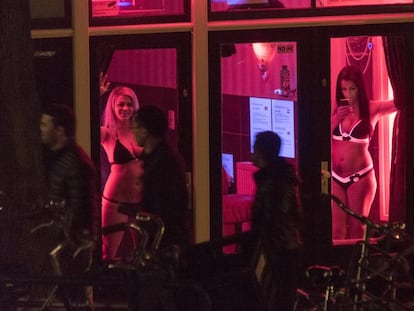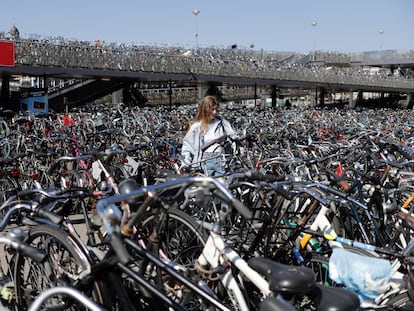In Amsterdam, a projected erotic center clashes with the European Medicines Agency
The new location would have space for 100 sex workers, along with restaurants, seminars and workshops. However, the neighbors aren’t happy: ‘let’s face it, it will be a mega-brothel’


At present, Amsterdam’s Red Light District has 249 windows from where sex workers compete for the attention of potential customers. It is one of the busiest areas in the Dutch capital, as well as one of the biggest causes of concern for its city council, due to the massive tourist crowds and the consumption of drugs and alcohol. Now, to relieve some of its burden, Mayor Femke Halsema plans to create a large erotic center away from the city center, with space for 100 sex workers “without distinction of gender and orientation” and areas for restaurants, arts and culture. Two of its three potential locations are close to the RAI Amsterdam Convention Center, where the European Medicines Agency (EMA), which this week expressed its concern, is also located.
The EMA, which is in charge of assessing the applications for the approval and marketing of medicines in the European Union, has asserted its position. In a statement that reflects the strain of the moment, they report that they are working closely with the European Commission and will keep it informed about this matter; they also express their regret at having found out about the plans for the erotic center in the press, when the process was already in the public consultation phase and without having received a direct message from the city council. The agency is concerned about the safety and security of its more than 900 employees, as well as that of the international delegates who enter and leave its premises, sometimes late in the evening, and stay at nearby hotels.
“The change of the location of the red light district is motivated by concerns of nuisance, drug-dealing, drunkenness and disorderly behavior,” reads the statement. “Locating the erotic center in close proximity to EMA’s building is likely to bring the same negative impacts to the adjacent area.” To support their words, they invoke the seat agreement that was signed by both the agency and the Netherlands, according to which the host state has the obligation to guarantee the security and peace of the facilities, avoiding disturbances in their vicinity.
Given the sensitivity of the situation, Mayor Halsema did not take long to answer: “They are not going to be neighbors,” assured a spokesperson. “Everyone can see on the map that there’s at least 500 meters [1,640 feet] between the EMA and the potential locations.” In addition, “the sex work will be carried out inside the complex, not on the street.” The statements can be seen as an exercise of damage control after the Dutch government’s efforts to attract this international organization, which was headquartered in London until 2019, when it moved to the Netherlands due to Brexit. Two years earlier, Amsterdam had been chosen by the European Council from a list of 19 cities that included candidates like Barcelona, Copenhagen, Milan and Vienna.
Guido Rasi, its director until 2020, stated at the time that the chosen city should be safe and attractive, and 65% of the staff agreed to move to the Dutch capital. In 2018, Pharmaceutical Engineering magazine calculated: “Amsterdam’s estimated economic windfall [from the arrival of the EMA] is $1 billion.” It is not just a matter of the estimated 36,000 annual visits of experts, with its consequent boost for hotels and restaurants; it is also the support for projects and research groups, which stimulate the Dutch academic world.
“Let us stay in the Red Light District”
Prostitution has been legal in the Netherlands since 2000, but not on the streets, and the Red Light District’s problems are recurring. Located in the old town, the windows that attract tourists date back to the beginning of the 20th century and have been multiplying since 1960. Guided tours are not allowed since 2020, and neither is drinking outdoors. However, the area still faces pressure due to the flow of people, which makes life difficult for the approximately 4,500 residents. At dawn, revelers sing and shout, throw objects and take drugs, according to observations made by the city council’s own personnel.
Mayor Halsema has recognized that sex is a part of Amsterdam that will not disappear, but said the situation in the Red Light District is “unsustainable.” With the new project she hopes to obtain “an erotic center that has a certain class and distinction and is not a place where only petty criminals and the most vulnerable women congregate,” and which offers a program on eroticism and sexuality, with seminars and workshops on health and social inclusion. The city plans to cede the land for the center, which will be built and managed by outside companies. Meanwhile, on Tuesday, more than 250 residents of the area gathered and made their opinion clear: “They call it an erotic center, but let’s face it, it will be a mega-brothel,” said a woman. “And they want to build it in a residential neighborhood with lots of schools. That’s outrageous.”
Red Light United, the union for the Red Light District sex workers, states that only 7% of those affected see a future in the municipal plans. “No neighborhood expects an erotic center, so it is logical that the designated locations are already protesting. Let us stay in the Red Light District,” they plea in a statement posted on their website. The group does not want more windows to be closed there, and feels ignored by the mayor, states its president, Felicia Anna. “We were only allowed to show up to sign, so that the city could claim that this project came about in consultation with us. Nothing could be further from the truth. As long as the erotic center is done at the expense of the Red Light District windows, we will continue to oppose this project tooth and nail!” she wrote.
The other possible site mentioned in the municipal plans is called NDSM, and it is located on the former land of a shipbuilding company of the same name. It is an old pier north of the city that has been urbanized and now has art galleries, restaurants and a museum dedicated to graffiti, among other things. So far, there has been no reaction from the neighbors of that area.
Sign up for our weekly newsletter to get more English-language news coverage from EL PAÍS USA Edition
Tu suscripción se está usando en otro dispositivo
¿Quieres añadir otro usuario a tu suscripción?
Si continúas leyendo en este dispositivo, no se podrá leer en el otro.
FlechaTu suscripción se está usando en otro dispositivo y solo puedes acceder a EL PAÍS desde un dispositivo a la vez.
Si quieres compartir tu cuenta, cambia tu suscripción a la modalidad Premium, así podrás añadir otro usuario. Cada uno accederá con su propia cuenta de email, lo que os permitirá personalizar vuestra experiencia en EL PAÍS.
¿Tienes una suscripción de empresa? Accede aquí para contratar más cuentas.
En el caso de no saber quién está usando tu cuenta, te recomendamos cambiar tu contraseña aquí.
Si decides continuar compartiendo tu cuenta, este mensaje se mostrará en tu dispositivo y en el de la otra persona que está usando tu cuenta de forma indefinida, afectando a tu experiencia de lectura. Puedes consultar aquí los términos y condiciones de la suscripción digital.
More information
Archived In
Últimas noticias
Rowan Atkinson tops Netflix at 70: ‘He’s as funny as ever’
Israeli recognition of Somaliland stirs up the Gulf
Tiger Woods turns 50: Will he continue playing on the PGA Tour or take a back seat?
The surreal journey of James Nnaji, the Barcelona youth player selected in the NBA Draft who ended up in the NCAA
Most viewed
- Oona Chaplin: ‘I told James Cameron that I was living in a treehouse and starting a permaculture project with a friend’
- Reinhard Genzel, Nobel laureate in physics: ‘One-minute videos will never give you the truth’
- Sinaloa Cartel war is taking its toll on Los Chapitos
- Why the price of coffee has skyrocketed: from Brazilian plantations to specialty coffee houses
- Chevy Chase, the beloved comedian who was a monster off camera: ‘Not everyone hated him, just the people who’ve worked with him’










































